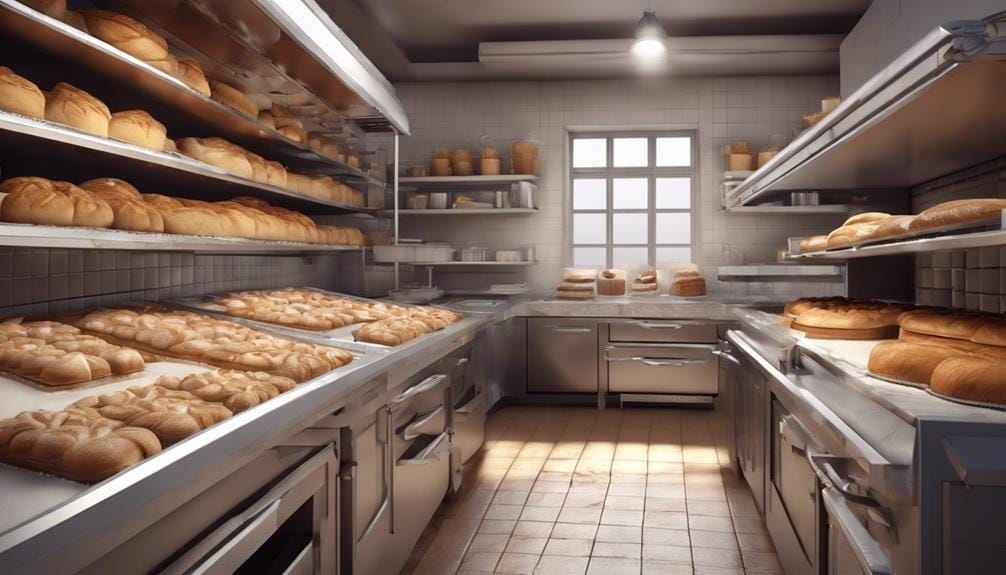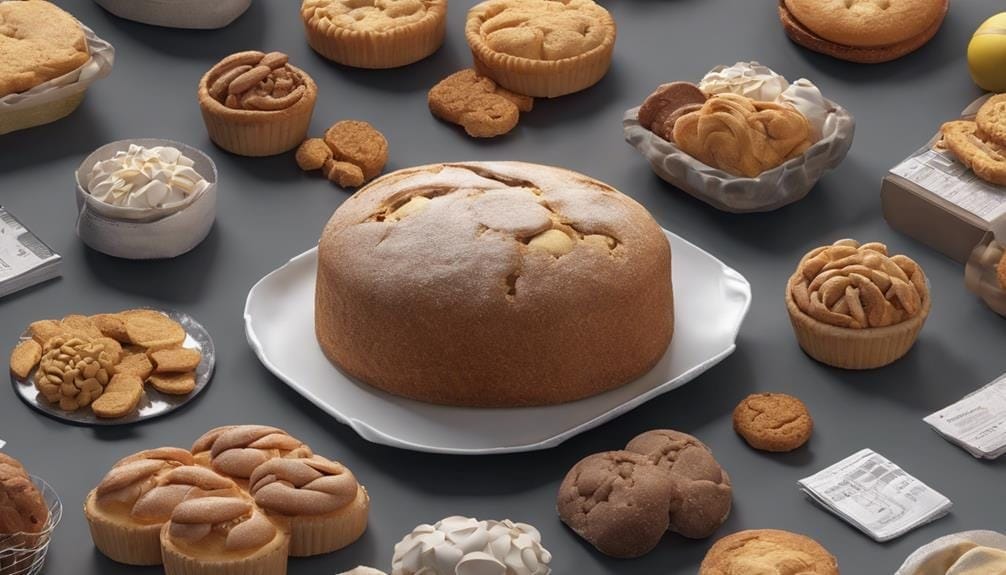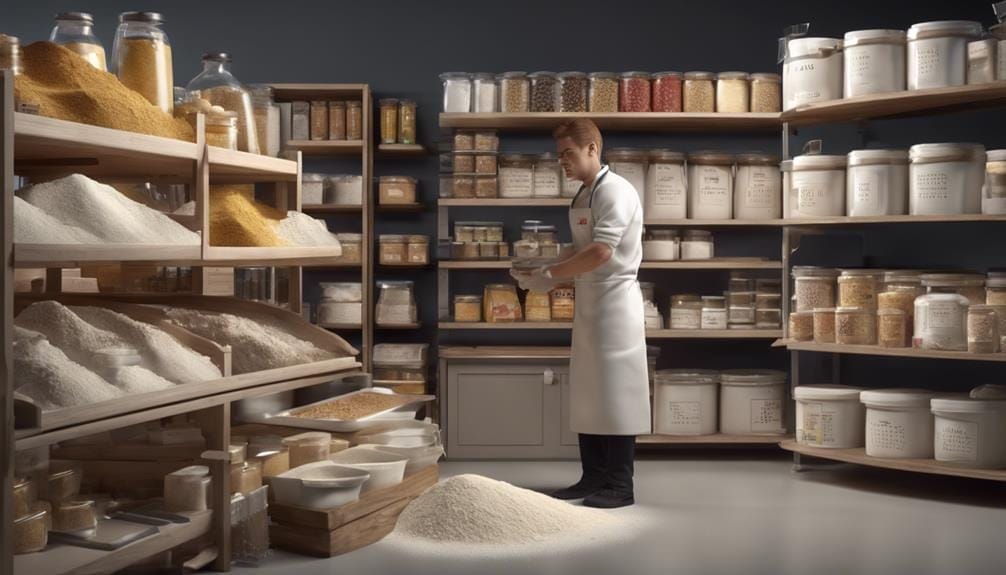To price your baked goods effectively, start by analyzing all production costs, from ingredients to overhead. Factor in labor expenses accurately, considering time, skill, and complexity. Guarantee your pricing covers all costs, including staff wages and crucial overhead like rent and utilities. Calculate your Cost of Goods Sold per item diligently to set selling prices for profitability. Calculate your profit margin carefully to evaluate financial health. Investigate different pricing strategies like Cost-Plus and Value-Based Pricing to optimize profitability. Consider dynamic pricing based on market trends for revenue optimization. Implement upselling strategies and efficient inventory management for increased sales and reduced costs.
Understanding Baked Goods Costs
To grasp the true costs of producing baked goods, carefully analyze the direct and indirect expenses involved in the process.
When determining the pricing of your goods, it's important to take into account not only the cost of ingredients but also labor and overhead expenses.
The total cost of goods sold (CoGS) per item should be calculated to make sure you cover all expenses and make a profit.
Quality ingredients may increase the cost of your goods but can also improve the final product, impacting your pricing strategy.
Incorporating Labor Expenses
Consider labor expenses when pricing your baked goods by factoring in wages for all staff involved in the baking process. To accurately reflect labor costs, calculate the labor cost per item by dividing the total labor expenses by the number of items produced.
It's important to factor in the time spent on each product, as labor costs can vary based on location, the skill level of employees, and the complexity of the baked goods. By incorporating labor expenses properly, you guarantee that your pricing covers all the costs involved in producing your baked goods.
For instance, a more intricate pastry requiring skilled labor and more time will have a higher labor cost per item compared to a simpler cookie. Understanding these factors will help you set prices that not only cover your labor expenses but also contribute to the overall profitability of your baked goods business.
Accounting for Overhead Costs

Account for your bakery's overhead costs to accurately determine the total cost of goods sold (CoGS) for setting profitable pricing.
Overhead costs in a bakery encompass both essential expenses like rent, insurance, and utilities, in addition to variable costs such as packaging materials and marketing.
By calculating these overhead costs correctly, you can guarantee that your selling prices cover all expenses and leave room for profit. Neglecting to incorporate overhead costs into your pricing strategy can lead to underpricing, ultimately impacting your profit margins.
To account for overhead costs effectively, it's vital to keep track of all expenses related to running your bakery. This includes both the fixed expenses that remain constant regardless of production levels and variable costs that fluctuate with your bakery's activities.
Calculating Cost of Goods Sold
Calculate the Cost of Goods Sold (CoGS) by totaling the direct expenses linked to producing your bakery's goods, such as ingredients, packaging, and labor.
To determine the CoGS for your bakery, add up the costs of all ingredients used in each baked good, including flour, sugar, eggs, and any other components. Include the expenses for packaging, such as boxes, bags, or containers, and factor in the labor costs for the time spent by you or your staff on baking and preparing the goods.
Use a pricing calculator to streamline the cost calculation process and guarantee accuracy.
By accounting for ingredient costs, labor costs, and packaging expenses, you'll have a clear understanding of the fixed costs associated with producing each item. Knowing your CoGS is essential for setting the right selling prices that cover all expenses and leave room for a profit margin.
Regularly reviewing and updating your CoGS calculations will help you make informed pricing decisions and maintain profitability in your bakery business.
Determining Profit Margin

To ensure your bakery's financial success, understanding your profit margin is vital in evaluating the efficiency of your cost management and general business health. Knowing how to determine your profit margin will assist you in pricing your baked goods effectively.
Here are some key points to keep in mind:
- Gross profit: Calculated by subtracting the cost per serving from the price of your bakery products.
- Net profit margin: This is the percentage of revenue that represents profit after deducting all expenses. It's an indicator of your bakery's profitability.
- Ideal Food Cost: Understanding the ideal food cost percentage helps in setting prices that cover expenses while ensuring profitability.
- Financial health: A higher profit margin signifies better financial health and efficiency in cost management, essential for the long-term sustainability and growth of your bakery business.
Pricing Strategies Overview
Consider incorporating different pricing strategies such as Cost-Plus, Value-Based Pricing, and Dynamic Pricing to determine the best selling price for your baked goods. By understanding the cost of ingredients, labor expenses, and overhead costs, you can make informed decisions when pricing your baked goods. Value-Based Pricing focuses on the perceived value of your products to the customer, while Dynamic Pricing allows you to adjust prices based on market trends and demand. These pricing methods are crucial for ensuring profitability and customer satisfaction in your bakery business.
| Pricing Strategy | Description |
|---|---|
| Cost-Plus | Adds a markup percentage to the total cost of production to determine the selling price. |
| Value-Based Pricing | Sets prices based on how much customers believe your baked goods are worth, focusing on value. |
| Dynamic Pricing | Adjusts prices in real-time based on market conditions, demand, competition, and other factors. |
Implementing Dynamic Pricing

When implementing dynamic pricing for your bakery, stay responsive to market changes by adjusting prices based on demand, competitor pricing, and time of day. Utilize data analytics to set dynamic pricing strategies that can help optimize profits and enhance sales during off-peak hours or slow periods.
Here are some key points to ponder:
- Stay Agile: Regularly monitor market trends and customer behavior to make informed pricing decisions.
- Utilize Data: Harness data analytics to identify patterns and adjust prices accordingly for different products.
- Optimize Timing: Experiment with pricing variations throughout the day to attract customers during peak and off-peak hours.
- Maximize Profits: Implement dynamic pricing strategies to not only enhance sales but also ensure you're optimizing revenue potential.
Maximizing Revenue With Upselling
Maximize your bakery's revenue potential by implementing effective upselling strategies that encourage customers to purchase additional items or upgrades. Upselling strategies can greatly increase revenue by offering complementary products that improve the customer experience and increase sales.
Consider suggesting higher-priced items or bundle deals to maximize the average order value. To guarantee successful upselling, train your staff to highlight the benefits and value of additional purchases. Utilize different methods such as signage, menu inserts, or digital displays to promote upselling opportunities to customers.
Efficient Inventory Management

Efficiently managing your bakery's inventory is vital for optimizing operations and ensuring smooth production processes.
To achieve this, consider implementing FIFO or LIFO inventory methods to effectively track stock movement.
Setting reorder points based on sales trends and conducting regular stock audits will help you adjust production levels accordingly.
Utilizing inventory management software can streamline your processes, improve inventory control, and boost cash flow management.
Remember to minimize excess inventory to reduce storage costs and improve financial efficiency.
Frequently Asked Questions
How Do You Determine the Selling Price of a Baked Good?
When determining the selling price of a baked good, you analyze costs, apply pricing strategies, consider ingredient and labor expenses, conduct market and competition research, include packaging costs, adjust for seasons, maintain pricing consistency, and factor in special events.
How to Price Items for a Bake Sale?
When pricing items for a bake sale, consider local competition, ingredients cost, packaging options, time investment, seasonal demand, brand reputation, location impact, special promotions, and customer preferences. Develop a pricing strategy that balances profit and appeal.
How Much Do You Mark up Baked Goods?
When pricing baked goods, consider different factors like ingredient costs, competitor analysis, and market research. Implement pricing strategies and models, factor in labor expenses, and use pricing psychology. Regularly review and adjust prices for consistency and profitability.
What Is a Good Profit Margin for Baked Goods?
To determine a good profit margin for baked goods, consider ingredient costs, overhead expenses, and market demand. Higher quality ingredients and unique recipes may justify a higher margin. Regularly monitor and adjust to guarantee sustainability.
Conclusion
To sum up, pricing baked goods requires a careful consideration of costs, labor, overhead, and profit margins. By following a structured approach and implementing effective pricing strategies, you can optimize revenue and guarantee your business's success.
Remember to regularly review and adjust your prices based on market demand and competition to stay competitive. With these tips and strategies in mind, you'll be well-equipped to price your baked goods accurately and profitably.